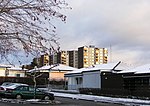Fittja metro station
Railway stations in Sweden opened in the 1970sRailway stations opened in 1972Red line (Stockholm metro) stationsStockholm Metro stubsSwedish railway station stubs

Fittja metro station is a station on the red line of the Stockholm metro, located in Fittja, Botkyrka Municipality, Sweden. The outdoor station was opened on 1 October 1972 as the south-western terminus of the extension from Vårberg. On 12 January 1975 the line was extended further to Norsborg.The station has a copy of the Carl Fredrik Reuterswärd bronze sculpture Non-Violence, the original of which was made in memory of John Lennon. Under the canopy roof of the entrance to Fittja center hangs two light sculptures of opal-colored plastic created by Eva Rosengren.
Excerpt from the Wikipedia article Fittja metro station (License: CC BY-SA 3.0, Authors, Images).Fittja metro station
Krögarvägen, Botkyrka kommun
Geographical coordinates (GPS) Address External links Nearby Places Show on map
Geographical coordinates (GPS)
| Latitude | Longitude |
|---|---|
| N 59.2475 ° | E 17.860833333333 ° |
Address
Fittja
Krögarvägen
145 52 Botkyrka kommun, Slagsta
Sweden
Open on Google Maps









